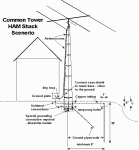Hi... I recommend a few minor changes, but they are really just loose ideas, and you are the one doing the work, so.....
1. The "temporary holes" should be permanent to allow for the inspection of connections.
2. The coax shield ground should be connected to ground at the entry panel, not on the tower.
Language is funny, when you say "soldered", do you mean "welded", there is a huge difference, welding or mechanical connections (with listed components) are required for grounds (actually "brazing" or "exothermic welds", usually with a little thermite )) Exothermic welds are done with a little cup of thermite mixture in a clay thing, that you light and automatically welds the wire and rod together (CADWELD makes them).
Pipes, rods, and tubes, are different. wouldn't recommend a pipe or tube for anything here. (partially usable, just not recommended).
Also... and this could be important.... All towers that I have seem, have the ground ring bonded to the tower ABOVE the base, otherwise you could put a lightning bolt through the concrete, risking structural damage...
page 1-17 and 1-19 could be informative.
Basically go by the National electrical code, and use all other information for clarification.
I hope this helps as well as the other well thought out comments.
Thanks
Joel


